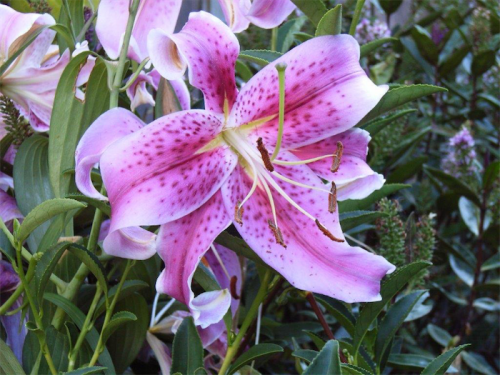
Incidentally, once spring bulbs have finished, there’s no need to wait until the leaves have died before removing them, just wait six weeks after flowering and the leaves can be cut to ground level.
Summer flowering bulbs include Belladonna lilies or Amaryllis. Once the Amaryllis family included, crinum, nerine and hippeastrums. Now Amaryllis belladonna is considered to be the only true Amaryllis.
The common, easy-to-grow pink Amaryllis will grow anywhere, even under large trees. Always plant it with the neck above the ground. These are gross feeders, so mulch with rotted-down leaves mixed with cow manure.
Canna lilies provide height and bright colours for a backdrop to any garden bed. Liliums are a florist-shop favourite as a cut flower because the take a while to open into full flower.
Liliums have been grown in Europe for centuries and are synonymous with St. Anthony. Lilium candidum, with its pure-white flowers, is commonly called the Madonna lily. Many religious paintings show the Madonna holding a bunch of them. This variety is possibly the oldest cottage garden lily grown. With today’s plant breeding, they come in a multiplicity of colours. Liliums flower from December to March
Every garden should have at least a few groups of Tuberose, which flower from February to April. Some garden books and catalogues list it as Polianthes, its correct name.
It was introduced from Mexico and loves the heat. It was first introduced to England in 1629 and has been popular ever since. Although I have listed it here among bulb suggestions, in fact it is a perennial. Many catalogues list it as a bulb.
Continue to plant a few Gladioli each week between now and the first week in December, they will then progressively flower over a long period of time.
A true autumn bulb is Nerine Bowdenii or pink spider flower, and there is a white variety. They have a subtle fragrance and last an incredibly long time in a vase.
Finally, two other bulbs certainly worth including in the garden include Acidanthera bicolor or peacock orchid and Eucomis punctata or pineapple lily.
Most “bulbs” listed above will all grow well in containers, although many have vigorous roots and need containers not less than 30cm-40cm across. Place a layer of charcoal (available from most garden centres) in the bottom to act as drainage and keep the soil sweet.
Don’t be niggly, plant in bold groups and mix with perennials also planted in bold groups. Combined, they can then make a continuous floral display all the way to the end of autumn.
NOW is a good time to re-pot indoor plants, especially if they have been in the same potting mix for years.
Shake as much of the old potting mix off the roots. In the bottom of the pot put a layer of charcoal (as mentioned above for potting up bulbs). Use only top-grade potting mix such as the Debco brand.
Eighty per cent of indoor plants die due to poor drainage, invariably with water sitting in the saucer, which inhibits the potting mix to drain and the result is root rot.
Overcome this by filling the saucer with small pebbles and place the container on top of the pebbles. Decorative, coloured pebbles that suit the colour of the container can be found in pet shops for the bottom of aquariums.
Jottings…
- Check garden taps for dripping. They may need new washers.
- Remove spent flowers on roses and feed with Seamungus, a combination of seaweed and chook poo.
- Try growing climbing roses up through trees, especially the thorn-less “Zephirine Drouhin”.
- Be sure to keep whipper snippers well away from the trunks of trees and shrubs.
Who can be trusted?
In a world of spin and confusion, there’s never been a more important time to support independent journalism in Canberra.
If you trust our work online and want to enforce the power of independent voices, I invite you to make a small contribution.
Every dollar of support is invested back into our journalism to help keep citynews.com.au strong and free.
Thank you,
Ian Meikle, editor




Leave a Reply